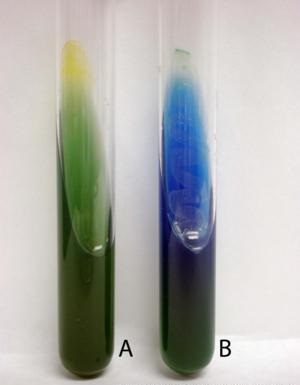Citrate Test - Principle, Biochemistry, Media, Procedure, Result, Interpretation
Introduction to Citrate Test
The citrate utilization test is a biochemical test used to determine if the test organism is able to metabolize citrate as the sole of carbon and energy with resulting alkalinity.
Media used for Citrate Test
For the citrate utilization test, Simmon's citrate agar is used. It contains sodium citrate as the only source of carbon and energy and indicator bromothymol blue. The medium also contains inorganic ammonium salts.
Principle, Biochemistry of Citrate Test
Most bacteria utilize citrate rapidly through the tricarboxylic cycle or citrate fermentation pathway, the principle of the citrate utilization test falls upon ir. Instead of coenzyme A, citrate-positive bacteria produce citrate lyase (citrate oxaloacetate lyase). Magnesium and manganese supply a divalent cation for the bacterial enzyme to cleave the citrate.
The citrate is broken down to oxaloacetic acid and acetic acid as intermediate products which are later converted to pyruvic acid and carbon dioxide.
Biochemistry:
Cirtate → oxaloacetate + acetate → pyruvate + CO2
The CO2 thus generated reacts with sodium and water to form the alkaline product sodium carbonate which in turn changes the color of the indicator (bromothymol blue) from green to blue. This change in the color of the media indicates a positive citrate test.
Inorganic ammonium salts are also present in Simmon,s citrate agar. A citrate-positive organism also is able to utilize ammonium salts as its sole nitrogen source. The microorganism cleaves the ammonium salts to produce ammonia which is also alkaline in nature- resulting in a color change from green to blue.

Fig: Citrate negative (A), positive (B) (Source: ASM MicrobeLibrary)
Procedure of Citrate Test
The Citrate Test is done by undergoing the following procedure:
Take a sterile test tube containing Simmon's citrate medium. (the medium should have a long slant and a short butt)
Pick a fresh culture of the test organism with sterile inoculating wire followed by inoculation on the surface slope.
Incubate the inoculated tube at 35-37°C for 18-24 hours. (for control, an uninoculated tube with media is incubated).
Observe for color change in the citrate medium.
Result, Interpretation of Citrate Test
The result and interpretation of the result for the citrate test are as follows.
Positive
Microorganisms are able to grow on the surface of the media and the color of the media changes from green to blue.
Negative
No growth and no change in the color of media are noted.
Citrate positive bacteria
Microorganisms showing positive citrate tests are
Klebsiella sp. (including K. pneumoniae)
Enterobacter sp.
Salmonella sp.
Raoultella planticola
Frateuria aurantia
Citrate negative bacteria
Microorganisms showing negative citrate tests are
E. coli
Edwardsiella sp.
Proteus myxofaciens